Abstract
Under the new wave of scientific and technological revolution, the construction industry finds itself with a critical need to alter the traditional and outdated production mode through technological innovation in order to realize industry transformation and move towards a new era characterized by digitalization, informatization, and intelligence. As intelligent construction is the indispensable pathway for the transformation and upgrading of the construction industry, it is of great significance to conduct in-depth research on its evaluation indicators and causality. This paper adopts the system dynamics method, based on the overall structure of intelligent construction, extracts the causality chain and causal feedback loop of intelligent construction, and presents a causality diagram and system dynamics diagram to build a robust system dynamics model for intelligent construction. On this basis, an evaluation index system for intelligent construction is constructed from the five dimensions—investment, design, construction, operation, and environment—for a holistic assessment of the current state of intelligent construction. The research aims to provide a valuable reference for professionals focusing on intelligent construction and the broader development of the industry.
1. Introduction
As a crucial pillar of the China’s economy, the construction industry lends great support to the sustainable development. However, the current production mode in the construction industry remains relatively traditional, causing notable differences when compared to the requirements for high-quality development that involves efficiency improvement, structural optimization, and innovation-driven, green development [1]. With the introduction of new infrastructure policy and directives from the Ministry of Housing and Urban-Rural Development, the Ministry of Science and Technology, the National Development and Reform Commission, and other relevant departments in the issuance of guidance on “promoting the coordinated development of intelligent construction and building industrialization”, digitalization in the construction industry refers to the use of digital technologies to streamline and automate processes. Informatization involves the extensive collection, processing, and use of information to enhance decision-making and productivity. Intelligence in construction incorporates artificial intelligence (AI) and smart technologies to predict outcomes, optimize operations, and improve safety and efficiency, marking a shift towards more adaptive and responsive construction practices. How to use policy dividends; seize the opportunity in informatization, digitalization, and intelligent development; and realize construction enterprise “intellectualization” transformation and upgrading have become crucial imperatives for the industry and, notably, for small- and medium-sized enterprises [2]. For a long time, the construction industry has suffered problems such as low information levels, extensive management, serious waste, and low efficiency. The leading cause of these problems lies in the lack of technological innovation. According to McKinsey’s 2019 report “China in the Digital Era: Building a New Economy with Global Competitiveness”, the construction industry’s level of informatization is only marginally higher than that of agriculture. Investments in new technology and scientific research and innovation accounted for less than 1% of the total revenue [3].
Intelligent construction represents the development direction of construction 4.0. It encompasses all stages of a building’s life cycle, including design, construction, operation, and maintenance. It is based on civil engineering construction technology and is supported by modern information and intelligent technologies. Guided by project management theory, intelligent construction is represented by intelligent management information systems. By constructing a digital twin model and establishing bidirectional mapping between the real and virtual worlds, intelligent construction enables the perception, analysis, and control of the construction process and buildings. The result is a refined, high-quality, and efficient civil engineering construction mode. Intelligent construction has become a requirement for innovative development in the construction industry [4,5]. The emergence of “intelligent infrastructure” presents a critical opportunity for small- and medium-sized enterprises, which enhances the efficiency and precision of traditional infrastructure construction but also provides feasible solutions for the intelligence, digitalization, and industrialization of engineering projects, which greatly improves the production and management standards of engineering projects [6,7].
In recent years, many scholars have directed considerable attention to the research on intelligent construction. Štefanič et al. [8] delve into the application of intelligent construction in the construction stage. Ding [9], on the other hand, reconstructs the construction industry from the aspects of construction mode, business philosophy, product form, market form, and industry management. Tian [10] emphasizes the importance of intelligent construction. Taking the coal mining enterprises as an example, Tian illustrates that when the intelligent construction of coal mining enterprises is in the mature stage, with the improvement in the cost and benefits of intelligent construction, the “intelligent construction” strategy will become a general consensus of coal mining enterprises. Wang [11] believes that the advanced intelligent construction concept involves the adoption of the most advanced technology to replace the traditional construction means, which aims to optimize natural resource utilization, greatly improve the construction environment, and enhance project control, ultimately fostering the long-term healthy development of the construction industry. Intelligent construction, as a brand new construction model, will change the traditional construction industry and affect the entire industrial chain. This model will reshape production modes, production factors, and production relations and will require technological and managerial transformations. The various elements in the intelligent construction system are interwoven to form an organic whole characterized by dynamics, complexity, and nonlinearity. In the research on intelligent construction evaluation systems, You et al. [12] introduce the concept of “information-physics” fusion and provide a crucial framework for the development of the field of intelligent architecture. This framework explores five key features: digital twin (the process of digitizing and modeling the composition, features, functions, and performance of physical entities using information technology), data-information-driven, ubiquitous link, object-oriented work, and system autonomy. In addition, it proposes a new, sustainable, and measurable model for technology development and a complete set of competency testing criteria. Through the application of G1, the COWA empowerment method, and TOPSIS technology, Liu et al. [13] successfully developed a new, measurable, and intelligent management system for road and railway construction projects. Moreover, Chen et al. also proposed a new three-layer architecture of “capability element-capability domain-sub-capability” and its corresponding five levels of intelligent management system [14]. The application of gray system theory enables the comprehensive measurement and analysis of the level of intelligent construction within construction companies.
However, since conventional empirical approaches may fall short in the study of the links between different factors, it has become inevitable to use more complex, interdisciplinary, new approaches, such as system dynamics (SDs) [15]. SDs offer a comprehensive framework for understanding and addressing complex problems across various domains by modeling the intricate interactions and feedback loops within systems. Its holistic approach integrates diverse factors—social, economic, environmental, and technological—providing valuable insights into system behavior over time. SDs support strategic decision-making through scenario testing and sensitivity analysis, allowing for the exploration of potential policies and interventions before implementation. Moreover, its visual modeling tools enhance communication among stakeholders, facilitating a shared understanding of complex dynamics. This adaptability, combined with the ability to incorporate both quantitative and qualitative data, makes SDs an invaluable tool for forecasting, strategic planning, and fostering systemic change, thereby offering a versatile approach to tackling multifaceted challenges in a wide range of fields [16,17]. At present, the system dynamics method has been applied to the study of the productivity influence factors of green construction enterprises [18], analyses on the carbon emission process of the construction industry at different stages. [19], and research on urban solid waste management and urban earthquake disaster reduction evaluation systems [20,21]. The development of intelligent construction technology facilitates the understanding of causal relationships but also exhibits characteristics of multiple circuits, making it an indispensable component of complex social and economic management systems. Therefore, the system analysis method proves highly suitable for comprehensive analysis of the various factors of intelligent construction and further evaluation of their influence.
In summary, the transformation of intelligent construction brings opportunities and major changes to the engineering construction industry, especially for small enterprises, given their constraints in talent, scale, capital, and technology. Therefore, in the process of their own transformation, it is crucial to maximize their own advantages. Resources should be concentrated on breaking through some key links of engineering construction. With this in mind, the paper aims to study the influence mechanism among the subsystems within the intelligent construction system, explore the important factors within the system as variables, and construct a dynamic model of the intelligent construction system. This paper focuses on dynamic feedback loops and causality chains within the intelligent construction ecosystem, which divides the intelligent construction system into five subsystems: input, design, construction, operation, and environment. The overall structure is analyzed using an intelligent construction system model. According to the system dynamics model, the paper reveals the mutual relationship among elements within each system. Additionally, it constructs an evaluation index system including five second-level indexes and twenty-six three-level indexes from the five dimensions of intelligent construction input, design, construction, operation, and environment. Through evaluation and analysis of the input, design, construction, operation, and environment subsystems, it aims to provide a valuable reference for the development of the industry.
2. Connotation and Theoretical Framework of Intelligent Construction
2.1. Connotation of Intelligent Construction
The increasing integration of industrialization and information technology has brought intelligent construction into focus, including discussions on the theoretical system, various single-point application scenarios, and the overall intelligence of the construction industry. However, the current academic understanding of these concepts remains insufficient. Many scholars have proposed different interpretations of intelligent construction according to their respective research. For instance, Guo and Li [22] view the core idea of intelligent building as the organic combination of informatization, industrialization, and other fields through the introduction of advanced technology, all kinds of original labor organization, management mode, management philosophy, such as organic structure transformation, and the organic combination of various factors to improve building quality, safety, and sustainability. The goal is to achieve time savings, cost reductions, and service optimization. Dewit [23] emphasizes the transformation of construction through the integration of robots to change the construction industry, reduce project costs, improve accuracy, minimize waste, and fortify resilience and sustainability. Ding [9] introduces the concept of intelligent building as a new engineering construction innovation mode. It is the integration of engineering construction and new information technology. Through standardized modeling, high-performance computing, and intelligent decision support, it aims to achieve digitally driven engineering project planning, planning and design, construction production, operational service integration, and efficient coordination. You et al. [24] present a comprehensive theoretical framework of intelligent architecture, which consists of 11 key components. Each component is explained in terms of its scientific connotation and reveals the internal logical connection between them. This paper believes that intelligent construction optimizes the investment, design, construction, operation, and maintenance through the collaborative development of information technology, advanced equipment and industrialization, and professional and technical personnel. The ultimate goal is to establish an efficient, intelligent, and sustainable construction mode.
2.2. The Components and System Structure of Intelligent Construction
The components of intelligent building systems exhibit considerable diversity. Based on previous discussions and research on the developmental influence of the construction industry, this paper undertakes a qualitative analysis using the feedback mechanism in the system dynamics model. Key factors were selected to form the feedback loop model. The selected elements mainly cover five dimensions: input, construction, design, operation and maintenance, and the environmental subsystem. Interactions among elements in these dimensions contribute to the dynamic system of intelligent construction. Elements within intelligent buildings contain technology, personnel, capital, equipment, information, policies, laws, and regulations, etc. Funding and personnel represent the core elements of intelligent construction, while equipment and information serve as supporting elements. Policy, laws, and regulations act as guarantee elements to facilitate contact between and restrict these elements. The intelligent construction system plays a leading role in the market; the government plays a regulating and guiding role. Attention is directed towards the cultivation of an intelligent construction environment. Universities, research institutions, and science and technology intermediaries contribute to the realization of the purpose and functions of the intelligent construction system.
The overall structure of intelligent construction reflects the connection and interaction among its various elements. In recognition of many random factors involved in intelligent construction, this study simplifies the analysis by dividing the intelligent construction system into four subsystems: input, design, construction, and operation and maintenance. At the same time, the impact of the environment on the intelligent construction process is considered an important subsystem during the overall structural analysis. Among them, the input, design, construction, and operation and maintenance subsystems mutually promote and restrict each other while carrying out their own behavioral activities, forming a closed-loop operation mode. At the same time, the environmental subsystem is at the support level of intelligent construction, providing support and affecting its operation. The composition of the intelligent construction system and the interaction relationships among the subsystems are illustrated in Figure 1.
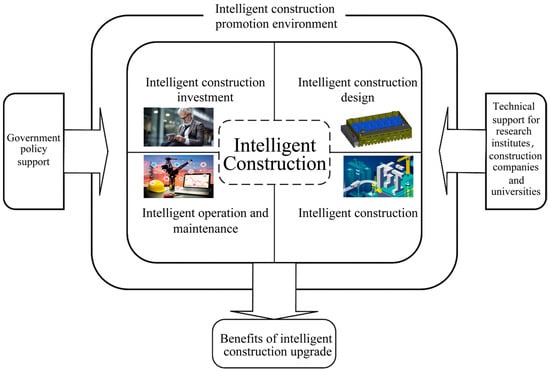
Figure 1.
Structure of the intelligent construction system.
3. System Dynamics Model Construction of Intelligent Construction
3.1. Definition of the Model Boundaries
The time span under consideration and the main variables studied determine the boundaries of the system. It is a basic principle to include variables closely related to the modeling objective and ensure the closure of the system boundary. Only after satisfying these two points can the system boundary be accurately demarcated [25,26]. The principal focus of this paper is intelligent construction; consequently, the system boundary aligns with the construction industry. In this paper, the construction industry is broadly encompasses construction, material production, environmental protection, and real estate. Considering the temporal dimension and combined with the previous analysis of the overall structure of intelligent construction, attention is directed towards the five subsystems of input, design, construction, operation, and environment as research factors to further study the causal feedback relationship within and between the systems.
3.2. Basic Assumptions
To facilitate the analysis, this paper temporarily ignores the secondary factors and simplifies the intelligent construction system into five subsystems. Before the construction of a model of an intelligent building system, it is essential to establish reasonable assumptions that enhance the understanding of the complexity and details in the system [27,28], without compromising simulation accuracy. Therefore, after thorough research and analysis, several effective assumptions are put forward; based on these assumptions, a complete model of the intelligent construction system has been constructed. These assumptions include the following:
- (1)
- The system of intelligent construction is intricate, necessitating compliance with certain rules and guidelines to guarantee its ongoing and seamless progression. Hence, the system of intelligent construction being analyzed must demonstrate steadiness to secure its lasting growth and preclude any sporadic leaps.
- (2)
- Considerations of the external milieu, significant shifts in governmental policies, and the influence of unforeseen events on the construction sector are momentarily set aside.
- (3)
- The advantages of the intelligent construction system are assessable via metrics like efficiency in construction, safety, expense, consumer contentment, and acknowledgment by the sector.
3.3. Systematic Causality Diagram
The flow diagram of the system dynamics is based on the causality diagram, wherein the causal interactions among various elements form the function and behavior of the system [29]. Therefore, the formation of the system mainly depends on the establishment of causal relationships in this system. Due to the complexity of the intelligent construction system, it includes five subsystems: decision-making, design, production, construction, and operation and maintenance. These subsystems are related to each other and all have their own unique functional and structural characteristics. Therefore, based on the overall structure of the intelligent construction system, this paper establishes a causal relationship chain and a causal feedback loop to analyze the operation of the system, as illustrated in Figure 2. The subsequent analysis delves into the following causal feedback loops:
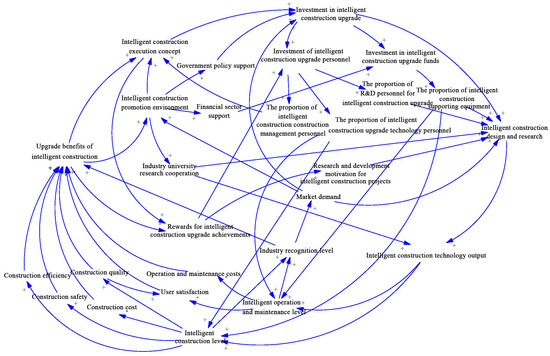
Figure 2.
Intelligent manufacturing causality.
- (1)
- Intelligent construction upgrade investment + intelligent construction design and research and development + intelligent construction technology output + intelligent construction operation and maintenance level/intelligent construction level + intelligent construction upgrade benefit + intelligent construction implementation concept + intelligent construction upgrade investment. This loop constitutes a positive feedback loop, reflecting the development of enterprise strategy, profit, industry recognition, customer satisfaction, and external environment and making decisions on the personnel investment and capital investment of intelligent construction transformation and upgrading according to the market demand.
- (2)
- Intelligent construction design and research and development + intelligent construction technology output + intelligent construction operation and maintenance level/intelligent construction level + intelligent construction upgrade benefit + intelligent construction promotion environment + combination of industry, university, and research + intelligent construction design and research and development/intelligent construction technology output. This loop is another positive feedback loop, reflecting the impact of intelligent construction design and development on the transformation and upgrading process of construction enterprises. Collaboration with educational institutions and research entities helps overcome technical barriers, increase research and development facilities, improve the project rate and technology yield, and enhance the enterprise construction and operations level, thus increasing the enterprise benefit and promoting the construction of an environment for intelligent construction.
- (3)
- Market demand + intelligent construction promotion environment + intelligent construction execution concept + intelligent construction upgrade investment + intelligent construction design and development + intelligent construction technology output + intelligent construction operation and maintenance level/intelligent construction level + industry recognition level + market demand. This positive feedback loop reflects the impact of market demand on the intelligent construction transformation and upgrading process of construction enterprises. Technological advancements leading to improved construction, operation, and maintenance levels will enhance industry recognition and corporate social image and stimulate user demand. Increased market demand further boosts intelligent construction to promote the transformation and upgrading of the construction industry.
- (4)
- Government policy support + investment in intelligent construction upgrade + intelligent construction design and development + design and construction technology output + intelligent construction operation and maintenance level/intelligent construction level + benefit of intelligent construction upgrade + intelligent construction promotion environment + government policy support. This positive feedback loop signifies the construction external environment’s impact on intelligent construction, with the government as the main driver for intelligent construction upgrading. Legal, tax, and fiscal incentives guide the construction enterprise to their consciousness regarding intelligent construction transformation and upgrading, increase investment in transformation and upgrading, and play a role in its regulation and guidance.
- (5)
- Financial sector support + capital investment for intelligent construction and upgrading + intelligent construction design and development + design and construction technology output + intelligent construction operation and maintenance level/intelligent construction level + intelligent construction upgrade benefit + intelligent construction promotion environment + support from financial sector. This positive feedback loop reflects the construction industry’s reliance on the external environment, with crucial support from the financial sector to meet the capital requirements of construction enterprises during the intelligent upgrade transformation. It promotes progress in intelligent construction design research and development, improves the technical yield, and fully embodies the intelligent building upgrade transformation in enterprises and the financial sector.
3.4. System Dynamics Model
Through the analysis of the causality in intelligent construction, this paper establishes six state variables for intelligent construction upgrade input; intelligent construction design, research, and development; intelligent construction technology output; intelligent construction operations level; and intelligent construction environment. The selected state variables include the input increment, R&D project rate, technology output, operational level increment, and environmental construction rate. The remaining variables are considered auxiliary variables or constants. According to the theory of system dynamics, the system dynamics model is constructed using Vensime 9.4.2 software, as shown in Figure 3.
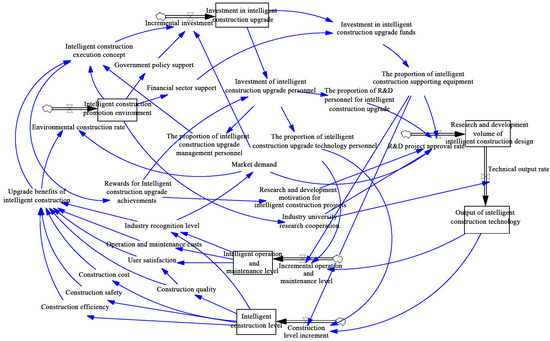
Figure 3.
System dynamics model of intelligent manufacturing.
4. Intelligent Construction Evaluation Index System
According to the rules revealed by the aforementioned system dynamics model of intelligent construction, this paper will construct an evaluation index system of intelligent construction from the five dimensions: investment, design, construction, operation, and environment of intelligent construction.
4.1. Evaluation Index of Intelligent Construction Input Subsystem
The advent of intelligent construction has changed decision-making paradigms from the traditional “Decision-making based on experience” to “Decision-making based on data”. In engineering and construction activities, a substantial volume of data is generated, which contains crucial information such as market trends and consumption patterns. By using new technologies to mine the rules of these data and to assist in the decision-making process, the utilization of data resources can be facilitated for well-informed choices. As illustrated in Figure 4, intelligent construction is initiated by investment in intelligent construction. With the enhancement of the implementation concept of intelligent construction in combination with a supportive environment for intelligent construction, including governmental and financial backing, enterprises increase their design and development of intelligent construction, as seen in the higher proportion of management personnel, technical personnel, and R&D personnel. Therefore, the fundamental investment indicators for intelligent construction are personnel and capital. Moreover, a portion of the R&D investment is allocated to non-intelligent upgrading, which also constitutes the basic elements and conditions of intelligent construction, basically reflected in the personnel and capital. In intelligent construction, the increase in economic benefits (e.g., internal rate of return) indirectly stimulates incremental investments in intelligent construction. Based on the above analysis, this paper mainly represents the status of the intelligent construction input subsystem, where personnel input is quantified by the proportion of intelligent construction R&D personnel and management personnel, while capital input is expressed through indicators of intelligent construction and upgrading equipment, technology introduction costs, and personnel training funds.
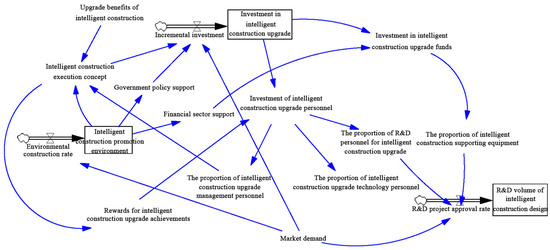
Figure 4.
System dynamic flow of intelligent construction upgrade input.
4.2. Evaluation Index of Intelligent Construction Design and Development Subsystem
As seen in Figure 5, the upgrade of intelligent construction design and development mainly focuses on the transformation of research and development project results to improve the level of construction, operation, and maintenance. Therefore, this paper selects intelligent construction research and development and the technology output rate as status variables. In the design R&D subsystem, the proportion of capital and R&D talents, coupled with the incentive of intelligent construction achievements, acts as the driving force behind R&D quantity. At the same time, industry–university–research cooperation enhances the technology output rate. For example, enterprises will cooperate with universities and research institutes to solve the technical challenges in intelligent construction. In addition, the informal conduct of intelligent builders also plays an important role in the promotion of research and development, such as consulting with external experts during the tumultuous stages of intelligent construction development and informal communication and communication among intelligent construction developers within the industry. Variables related to the number of intelligent construction developments and their relationships are shown in Figure 5. Based on the above analysis, this paper believes that the intelligent construction R&D subsystem can be explained by the following indicators: intelligent construction R&D power, the output rate of intelligent construction technology, communication with external consulting experts, informal communication, intelligent construction communication and cooperation, etc.
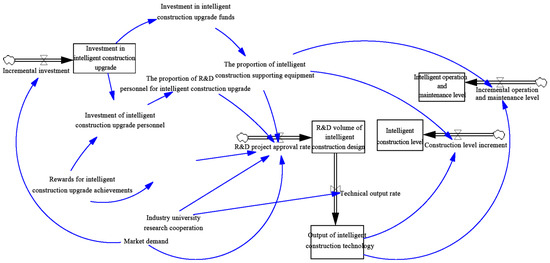
Figure 5.
System dynamic flow of intelligent construction design and development.
4.3. Evaluation Index of Intelligent Construction and Construction Subsystem
The improvement of the intelligent construction level plays an important role in the output of intelligent construction technology. The improvement can reduce material consumption in the building process, lower waste rates, improve the energy utilization rate, and, thus, decrease construction costs. In addition, the improvement can also optimize construction workflows and safety monitoring, especially for high-risk construction positions. The wide application of intelligent construction supporting equipment can effectively reduce employee accidents and improve safety. The improvement substantially impacts construction quality and efficiency. In the whole process of construction, the integration and promotion of new technology (such as the Internet of Things (a network based on information carriers such as the Internet and traditional telecommunications networks, which enable all ordinary physical objects that can be independently addressed to achieve interconnection), big data, remote sensing, automation, cloud computing, artificial intelligence, block chain, etc.), as well as the research and development, manufacturing, and application of advanced manufacturing equipment, intelligent equipment, and smart site-related tools, can upgrade construction machinery and amplify data resource utilization to boost quality and efficiency. It can also directly improve consumer satisfaction through tangible feedback on construction quality. Lower construction costs and higher construction safety, quality, and efficiency generate considerable transformation and upgrading benefits for construction enterprises. These upgrading benefits further promote the transformation and upgrading environment of intelligent construction. The system dynamic flow diagram of the intelligent construction subsystem for construction enterprises is shown in Figure 6. According to the analysis, this paper mainly uses the following indicators to characterize intelligent construction levels: shortening rate of the construction cycle, construction safety, reduced building material consumption rate, lowered energy consumption rate, the share of intelligent construction supporting equipment, the quality inspection pass rate, and more.
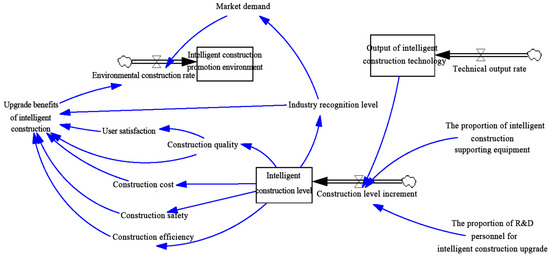
Figure 6.
System dynamic flow of intelligent construction.
4.4. Evaluation Index of Intelligent Construction, Operation, and Maintenance Subsystem
The improvement of the operational and maintenance levels in intelligent construction plays a crucial role in the output of intelligent construction technology. This improvement can reduce the need for building operation and maintenance personnel, lower labor costs, and improve the energy efficiency of buildings. In addition, it contributes to higher consumer satisfaction with operation and maintenance services, enhances public safety, and reduces the failure rate of building systems, such as power supply, water supply and drainage, and fire prevention equipment. The system dynamic flow diagram for the intelligent construction operation and maintenance subsystem within construction enterprises is shown in Figure 7. This paper mainly uses the following indicators to characterize intelligent construction and operation and maintenance levels: reduction in operation and maintenance labor costs, improved energy utilization efficiency in buildings, decreased failure rates of construction equipment, and enhanced user satisfaction with property service, among others.
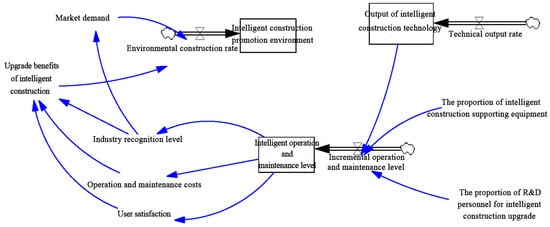
Figure 7.
System dynamic flow of intelligent construction operation and maintenance.
4.5. Evaluation Index of Intelligent Construction Environment Subsystem
Whether enterprises embrace the concept of intelligent building execution, whether their employees possess an awareness of intelligent building upgrade transformation, and whether enterprise managers recognize the importance of the intelligent upgrade transformation are critical factors. The enterprise’s innovation reward index for intelligent building directly impacts the enthusiasm of construction enterprises for intelligent building upgrade transformation, which, in turn, either promotes or hinders investment and implementation in the transformation and upgrading of intelligent buildings. Since these indicators revolve around construction enterprises and occur within enterprises, they can be summarized as the environment influencing the transformation and upgrading of construction enterprises. On the other hand, the external environment involves key players such as the government, financial departments, universities, and research institutes, which jointly provide economic resources and the overall economic environment and a supportive environment for scientific research. This external support system promotes intelligent construction, upgrading, and transformation initiatives within enterprises. The internal environment and the external environment jointly influence the upgrading and transformation process of intelligent construction, as shown in Figure 8. According to the analysis, this paper mainly employs the internal and the external environment to characterize the condition of the intelligent built propulsion environment subsystem. The internal environment includes aspects of construction enterprise culture, including the adoption of intelligent construction execution concepts and employee awareness. It also considers the institutional environment, such as the reward and punishment system. The external environment includes economic resources and the overall economic environment and a supportive environment for scientific research.
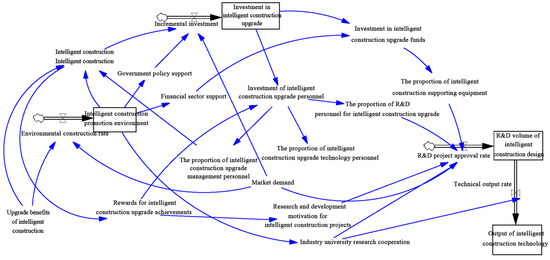
Figure 8.
System dynamic flow of intelligent construction environment.
4.6. Evaluation Index System of Intelligent Construction System
The aforementioned intelligent construction input subsystem index, design subsystem index, construction subsystem index, operation and maintenance subsystem index, and environment subsystem index are organically integrated together to form a comprehensive intelligent construction evaluation index system. This system contains five secondary indicators and twenty-six third level indicators, which comprehensively reflect the operation process of intelligent construction. The detailed breakdown of these indicators is presented in Table 1 below.

Table 1.
Evaluation index system of intelligent construction.
5. Effectiveness of the Case
This section illustrates the example of an intelligent construction and industrialization research and development base and its service project in Shaanxi Province. In its early stage, the base adhered to intelligent construction as the driving force behind the development of the construction industry and actively formulated strategies for the development of the intelligent construction industry. The base invests more than CNY 2 million annually in intelligent construction and equipment upgrades, with the technology introduction cost reaching CNY 1 million, and personnel training costs CNY 500,000. The number of management personnel exceeds 50, accounting for more than 70% of the total personnel in the base. Most operational processes are overseen by the management professionals operating the mechanical equipment. Half of the personnel in the base are technical experts, with much preliminary technical groundwork already undertaken. A total of 70% of the staff are dedicated to intelligent construction, including 30% focused on intelligent construction research and development, much higher than industry benchmarks. In terms of intelligent construction research and development, the base invests an annual investment of more than CNY 500,000, with the output of intelligent construction technology accounting for more than 80% of the total revenue. More than ten annual exchanges occur with external consulting experts. In the first five months of 2023 alone, the base conducted six informal technical exchanges and industrial collaboration. The base has effectively integrated intelligent construction research and development with on-site implementation, with widespread application of the research outcomes across various projects. In project construction services, there is an active deployment and adoption of intelligent construction equipment and systems, of which intelligent building equipment accounted for 36%. For instance, in the room installation construction process, the overall construction period has been dramatically reduced from 2 months to 0.5 months, with a 75% cycle shortening rate and enhanced construction security without any damage. At the same time, the base achieved a 35% reduction in on-site pipelines and other installed building materials, significantly lower than industry averages. Energy consumption reduction stands at 30%, and the quality qualified rate of primary installation surged to 97%.
In this study, a system dynamics analysis identified five secondary indicators and twenty-six tertiary indicators for evaluating intelligent construction. This section employs a questionnaire survey to investigate and determine the final system of impact factors by querying personnel from various sectors within the industry.
Based on the intelligent construction evaluation indicator system, which includes five secondary indicators and twenty-six tertiary indicators derived from system dynamics analysis, a survey titled “Intelligent Construction Evaluation Indicator Survey” was developed. The survey was conducted using a targeted questionnaire approach, focusing on professionals in the construction industry. The target respondents included personnel from government and public institutions, universities and research institutions, development and construction entities, survey and design firms, construction companies, consulting firms, supervisory and inspection entities, and others, totaling 174 individuals.
The survey comprised two parts. The first part collected basic information from the respondents, as shown in Table 2. The second part assessed the degree of impact of the evaluation indicators, as shown in Table 3. After collecting the surveys, data were compiled and analyzed to determine the influence of each indicator on intelligent construction evaluation.

Table 2.
Statistics of survey respondent information.

Table 3.
Degree of impact of the evaluation indicators.
Combining the aforementioned data and the method of the intelligent construction conceptual evaluation system based on system dynamics proposed in this paper, the application and promotion of intelligent construction throughout the entire process is anticipated to yield impressive benefits. Projections indicate a reduction of 30% in operation and maintenance labor costs, a 15% decrease in the failure rate of construction equipment, a 20% increase in building energy utilization efficiency, and a great enhancement in customer satisfaction.
In terms of the environmental construction of intelligent construction, the Intelligent Construction and Industrialization Research and Development Base believes that intelligent construction is the indispensable path for high-quality development of the construction industry. To shape innovation as the foremost driving force for the development of the base, a multi-category research group has been instituted. At the same time, an incentive mechanism for intelligent construction is in the process of establishment, designed to reward individuals and teams who deliver outstanding contributions to research and development and implementation on an annual basis. The total annual reward allocation is set at more than CNY 150,000. The base vigorously promotes the comprehensive development of intelligent construction, provides sufficient economic resources and various support mechanisms, constantly improves the product research and development and service capabilities of the base, and promotes the transformation of intelligent construction and high-quality development of the industry.
6. Conclusions
This paper focuses on dynamic feedback loops and causality chains within the intelligent construction ecosystem, which divides the intelligent construction system into five subsystems: input, design, construction, operation, and environment. The overall structure is analyzed using an intelligent construction system model. Through an examination of the logic of system variables and consideration of the feedback mechanism in system dynamics research, it is concluded that intelligent construction itself is a complex system with multiple feedback and cyclical interactions. It is the result of the connection and interaction among input, design, construction, operation, and environment. Therefore, according to the system dynamics model, the paper reveals the mutual relationship among elements within each system. Additionally, it constructs an evaluation index system including five second-level indexes and twenty-six three-level indexes from the five dimensions of intelligent construction input, design, construction, operation, and environment. The findings indicate that in the intelligent construction system the central role of the government, universities, research institutes, and technology intermediary agencies should be clarified. While emphasizing investment, design, construction, and operation and maintenance, it is crucial to strengthen the cultivation and improvement of the internal and external environment of intelligent construction to disrupt traditional construction processes, apply advanced information technology to realize intelligent construction, and strive for an efficient, intelligent, and sustainable construction mode.
The research in this paper not only provides an systematic, comprehensive, and reasonable reference for the practical operation of intelligent construction but also establishes a theoretical basis for further exploration within the construction industry. However, the value of considering the entire lifecycle should be considered, including deconstruction, for future research to fully embrace the principles of a circular economy. Intelligent construction is a comprehensive system involving theoretical and practical factors. As the intelligent construction standard system progresses into the practical application stage, updates and improvements are required. The role and value of legacy or historic intelligence and data as well as technological change are not extensively discussed in this paper. It will be necessary to verify the evaluation method proposed in this paper through case studies or experiments.
These issues require further discussion in future research combined with the actual situation.
Author Contributions
Conceptualization, Methodology, Investigation and Data Curation, Writing—Original Draft, J.G.; Methodology, Project administration, Writing—Review and Editing, W.S.; Visualization, Software, B.L. All authors have read and agreed to the published version of the manuscript.
Funding
This research received no external funding.
Data Availability Statement
The datasets generated during and/or analyzed during the current study are available from the corresponding author on reasonable request.
Acknowledgments
The authors would like to express their sincere gratitude to the editor and the anonymous reviewers for their insightful and constructive comments.
Conflicts of Interest
The authors declare no conflicts of interest.
References
- Pan, Y.-R.; Wang, J.; Lu, Z.; Liu, Y.-S.; Li, Y.-R. High-quality development in China: Measurement system, spatial pattern, and improvement paths. Habitat Int. 2021, 118, 102458. [Google Scholar] [CrossRef]
- Boadu, E.-F.; Wang, C.-C.; Sunindijo, R.-Y. Characteristics of the construction industry in developing countries and its implications for health and safety: An exploratory study in ghana. Int. J. Environ Res. Public Health 2020, 17, 4110. [Google Scholar] [CrossRef]
- Liu, Z.S.; Sun, X.T.; Shi, G.L. Summary of Application of Intelligent Construction in Civil Engineering Construction. Archit. Technol. 2021, 50, 40–53. (In Chinese) [Google Scholar]
- Qian, Q.H. The field of engineering construction should move towards intelligent construction. Constr. Archit. 2020, 18, 17–18. (In Chinese) [Google Scholar]
- Abd-Alhamid, F.; Kent, M.; Bennett, C.; Calautit, J.; Wu, Y. Developing an innovative method for visual perception evaluation in a physical-based virtual environment. Build. Environ. 2019, 162, 106278. [Google Scholar] [CrossRef]
- Kazemi, M.-Z.; Elamer, A.; Theodosopoulos, G.; Khatib, S. Reinvigorating research on sustainability reporting in the construction industry: A systematic review and future research agenda. J. Bus. Res. 2023, 167, 114145. [Google Scholar] [CrossRef]
- Cortés, D.; Traxler, A.; Greiling, D. Sustainability reporting in the construction industry—Status quo and directions of future research. Heliyon 2023, 9, e21682. [Google Scholar] [CrossRef]
- Štefanič, M.; Stankovski, V. A review of technologies and applications for smart construction. Proc. Inst. Civ. Eng.-Civ. Eng. 2018, 172, 83–87. [Google Scholar] [CrossRef]
- Ding, L.-Y. Digital Construction Introduction; China Building Industry Press: Beijing, China, 2019. [Google Scholar]
- Tian, Y.; Yang, X.; Yang, J.; Mao, K.; Yao, Y.; Liang, H. Evolution dynamic of intelligent construction strategy of coal mine enterprises in China. Heliyon 2022, 8, e10933. [Google Scholar] [CrossRef]
- Wang, L.; Huang, X.; Zheng, R. The application of BIM in intelligent construction. Appl. Mech. Mater. 2012, 188, 236–241. [Google Scholar] [CrossRef]
- You, Z.-J.; Wu, C. A framework for data-driven informatization of the construction company. Adv. Eng. Inform. 2019, 39, 269–277. [Google Scholar] [CrossRef]
- Liu, S.-Y.; Su, Y.-K. Research on intelligent construction capability evaluation of road and bridge construction enterprises. J. Eng. Manag. 2022, 36, 51–56. [Google Scholar]
- Chen, K.; Du, P.; Duan, W.-J. Research on maturity based intelligent construction capability evaluation model and application of construction enterprises. J. Eng. Manag. 2022, 36, 37–42. [Google Scholar]
- Zhong, Y.-G.; Jia, X.-J.; Qian, Y. System Dynamics; Science Press: Beijing, China, 2013. [Google Scholar]
- Yuan, H.-P.; Yang, B.-X. System dynamics approach for evaluating the interconnection performance of cross-border transport infrastructure. J. Manag. Eng. 2022, 38, 04022008. [Google Scholar] [CrossRef]
- Malbon, E.; Parkhurst, J. System dynamics modelling and the use of evidence to inform policymaking. Policy Stud. J. 2023, 44, 454–472. [Google Scholar] [CrossRef]
- Sun, G.-S.; Jiang, D.-L.; Zhang, X.-L. Study on the influencing factors of green construction enterprise productivity based on system dynamics. Constr. Econ. 2021, 42, 99–104. [Google Scholar]
- Zhang, Z.; Gao, Q.-F.; Shao, S. Carbon emission scenarios of China’s construction industry using a system dynamics methodology—Based on life cycle thinking. J. Clean. Prod. 2024, 435, 140457. [Google Scholar] [CrossRef]
- Sancheta, L.-N.; Chaves, G.L.; Siman, R.-R. The use of system dynamics on urban solid waste management: A literature analysis. Gest. Producao 2021, 28, e5336. [Google Scholar] [CrossRef]
- Zhao, H.; Dong, H.; Qu, W.-L. Constructing a dynamic risk evaluation system for environmental protection ppp projects based on improved system dynamics. Account. Mon. 2017, 65–71. (In Chinese) [Google Scholar]
- Guo, Z.; Li, L. A conceptual framework for collaborative development of intelligent construction and building industrialization. Front. Environ. Sci. 2022, 10, 904518. [Google Scholar] [CrossRef]
- Dewit, A. Komatsu, Smart construction, Creative destruction, and Japan’s robot revolution. Asia-Pac. J. Ophthalmol. 2015, 13, 2. [Google Scholar]
- You, Z.-J.; Wu, C.; Liu, Z.-W. Review of intelligent construction research. J. Civ. Eng. Manag. 2022, 39, 82–87+139. [Google Scholar]
- Liu, J.P.; Zhou, X.H.; Wu, Z.; Cao, L.; Feng, L.; Li, D.S. Intelligent Construction Basic Algorithm Tutorial; China Architecture & Building Press: Beijing, China, 2021. [Google Scholar]
- Bala, B.-K.; Arshad, F.-M.; Noh, K.-M. System Dynamics: Modelling and Simulation Singapore; Springer: Berlin/Heidelberg, Germany, 2017. [Google Scholar]
- Kazantsev, N.; Petrovskyi, O.; Müller, J. From supply chains towards manufacturing ecosystems: A system dynamics model. Forecast Soc. Chang. 2023, 197, 122917. [Google Scholar] [CrossRef]
- Naveed, F.; Khan, K.I.A. Investigating the influence of information complexity on construction quality: A systems thinking approach. Eng. Constr. Archit. Manag. 2021, 29, 1427–1448. [Google Scholar] [CrossRef]
- Riaz, H.; Khan, K.; Ullah, F.; Tahir, M.; Alqurashi, M.; Alsulami, B. Key factors for implementation of total quality management in construction sector: A system dynamics approach. Ain Shams Eng. J. 2023, 14, 101903. [Google Scholar] [CrossRef]
Disclaimer/Publisher’s Note: The statements, opinions and data contained in all publications are solely those of the individual author(s) and contributor(s) and not of MDPI and/or the editor(s). MDPI and/or the editor(s) disclaim responsibility for any injury to people or property resulting from any ideas, methods, instructions or products referred to in the content. |
© 2024 by the authors. Licensee MDPI, Basel, Switzerland. This article is an open access article distributed under the terms and conditions of the Creative Commons Attribution (CC BY) license (https://creativecommons.org/licenses/by/4.0/).